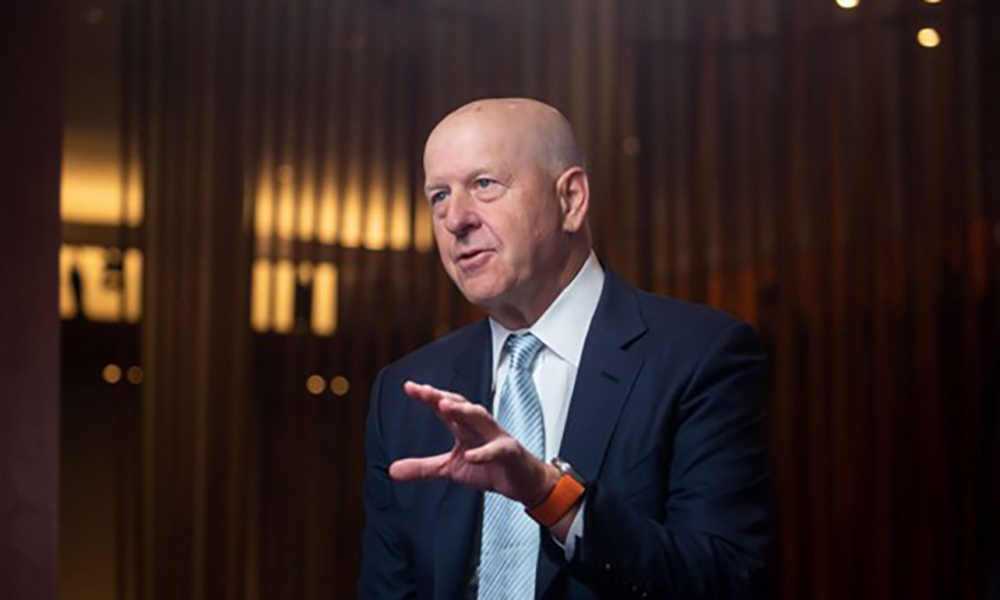
硅谷银行、专注于加密货币行业的签名银行(Signature Bank),以及瑞士信贷近期的风波,引发了银行业动荡。每当银行陷入动荡的时候,他们就会变得越来越保守。他们会更有选择性地发放贷款,经常会提高贷款利率,并且会预留更多现金保护自己,避免发生最糟糕的银行挤兑。
这些更严格的贷款标准可能造成信用紧缩,使消费者和企业很难获得资本,这将对经济产生显著影响。近期,对信用紧缩的担忧让人们再次预测美国即将陷入经济衰退。但高盛首席经济学家兼全球投资研究主管贾恩·哈奇乌斯认为,银行业最近的问题和持续信用紧缩,可能帮助美联储给经济降温,这有助于应对通胀。
他在周二的一篇报告中提到快速降息时称:“我们的基准预期是,减少信用可用性将是一场‘逆风’,能帮助美联储维持低于潜在水平的经济增长……但它不会演变成一场‘飓风’,使经济陷入衰退,迫使美联储积极采取货币宽松政策。”
过去一年,为了控制通胀,美联储官员的加息速度远超过史上任何其他时期。去年6月,美国通胀率达到四十年以来的最高水平,为9.1%。与哈奇乌斯的观点相同,在上周召开的一次新闻发布会上,美联储主席杰罗姆·鲍威尔表示,更严格的贷款标准可以起到与加息相同的抑制通胀的效果。
随着银行减少发放贷款,企业将更难通过投资实现业务增长,消费者很难获得贷款买房或买车,这确实会给经济降温。但这是一种微妙的局面。如果贷款标准过于严格,就像美联储多度加息一样,经济可能下滑,最终引发衰退。
但哈奇乌斯并不认为硅谷银行最近的问题会导致银行过度限制贷款。他认为,大银行会继续发放贷款,因为“他们的资本和流动性标准高于小银行,并且要接受监管部门更严格的压力测试”,这让他们在面对财务压力的时候更有弹性。
哈奇乌斯还表示,现在就预测银行业最近的问题会产生哪些长期影响,仍为时尚早。他预测未来12个月,美国陷入经济衰退的概率从上个月的25%提高到35%;并且他承认,硅谷银行的破产“显然会给经济带来更大规模的负面影响”。
日益严重的经济下行风险
哈奇乌斯周二列举了在基准情境下的两种关键风险:最近美国银行业的动荡,更像是抑制美国经济增长的“逆风”,而不是直接引发美国经济衰退的“飓风”。
首先他警告,在硅谷银行倒闭后消费者变得小心翼翼,可能会再次发生银行挤兑。他说道:“降低这种风险最有效的方式是提供无限制的存款担保。然而,这可能需要国会通过一项法案,但在危机变得更严重之前,国会不大可能通过任何法案。”
美国财政部长耶伦上周表示,如果再次发生银行挤兑,她会启用“系统性风险例外条款”来保护储户。系统性风险例外条款支持联邦存款保险公司支付超过25万美元保险限额的存款。
哈奇乌斯写道:“至少在目前来看,这条消息似乎起到了作用。”他还表示,硅谷银行倒闭后,从美国银行流出的存款规模创历史记录,但他看到的数据表明,过去一周,流出存款规模已经有所减少。
他还表示,在社交媒体和数字银行时代,“储户只需要在应用内简单操作就能快速转移资金”,因此银行需要支付更高利息以吸引储户,这是一个长期问题。
他写道:“这是在数字时代真正发生的第一次混乱状况。人们依旧担心银行偿付能力问题,再加上对低存款利率的不满,二者可能共同产生影响。这会给银行的募资成本带来更大的上行压力,给信用可用性带来更大的下行风险,其影响将超过我们统计分析的预测结果。”(财富中文网)
翻译:刘进龙
审校:汪皓
硅谷银行、专注于加密货币行业的签名银行(Signature Bank),以及瑞士信贷近期的风波,引发了银行业动荡。每当银行陷入动荡的时候,他们就会变得越来越保守。他们会更有选择性地发放贷款,经常会提高贷款利率,并且会预留更多现金保护自己,避免发生最糟糕的银行挤兑。
这些更严格的贷款标准可能造成信用紧缩,使消费者和企业很难获得资本,这将对经济产生显著影响。近期,对信用紧缩的担忧让人们再次预测美国即将陷入经济衰退。但高盛首席经济学家兼全球投资研究主管贾恩·哈奇乌斯认为,银行业最近的问题和持续信用紧缩,可能帮助美联储给经济降温,这有助于应对通胀。
他在周二的一篇报告中提到快速降息时称:“我们的基准预期是,减少信用可用性将是一场‘逆风’,能帮助美联储维持低于潜在水平的经济增长……但它不会演变成一场‘飓风’,使经济陷入衰退,迫使美联储积极采取货币宽松政策。”
过去一年,为了控制通胀,美联储官员的加息速度远超过史上任何其他时期。去年6月,美国通胀率达到四十年以来的最高水平,为9.1%。与哈奇乌斯的观点相同,在上周召开的一次新闻发布会上,美联储主席杰罗姆·鲍威尔表示,更严格的贷款标准可以起到与加息相同的抑制通胀的效果。
随着银行减少发放贷款,企业将更难通过投资实现业务增长,消费者很难获得贷款买房或买车,这确实会给经济降温。但这是一种微妙的局面。如果贷款标准过于严格,就像美联储多度加息一样,经济可能下滑,最终引发衰退。
但哈奇乌斯并不认为硅谷银行最近的问题会导致银行过度限制贷款。他认为,大银行会继续发放贷款,因为“他们的资本和流动性标准高于小银行,并且要接受监管部门更严格的压力测试”,这让他们在面对财务压力的时候更有弹性。
哈奇乌斯还表示,现在就预测银行业最近的问题会产生哪些长期影响,仍为时尚早。他预测未来12个月,美国陷入经济衰退的概率从上个月的25%提高到35%;并且他承认,硅谷银行的破产“显然会给经济带来更大规模的负面影响”。
日益严重的经济下行风险
哈奇乌斯周二列举了在基准情境下的两种关键风险:最近美国银行业的动荡,更像是抑制美国经济增长的“逆风”,而不是直接引发美国经济衰退的“飓风”。
首先他警告,在硅谷银行倒闭后消费者变得小心翼翼,可能会再次发生银行挤兑。他说道:“降低这种风险最有效的方式是提供无限制的存款担保。然而,这可能需要国会通过一项法案,但在危机变得更严重之前,国会不大可能通过任何法案。”
美国财政部长耶伦上周表示,如果再次发生银行挤兑,她会启用“系统性风险例外条款”来保护储户。系统性风险例外条款支持联邦存款保险公司支付超过25万美元保险限额的存款。
哈奇乌斯写道:“至少在目前来看,这条消息似乎起到了作用。”他还表示,硅谷银行倒闭后,从美国银行流出的存款规模创历史记录,但他看到的数据表明,过去一周,流出存款规模已经有所减少。
他还表示,在社交媒体和数字银行时代,“储户只需要在应用内简单操作就能快速转移资金”,因此银行需要支付更高利息以吸引储户,这是一个长期问题。
他写道:“这是在数字时代真正发生的第一次混乱状况。人们依旧担心银行偿付能力问题,再加上对低存款利率的不满,二者可能共同产生影响。这会给银行的募资成本带来更大的上行压力,给信用可用性带来更大的下行风险,其影响将超过我们统计分析的预测结果。”(财富中文网)
翻译:刘进龙
审校:汪皓
When banks face instability—as they are now after Silicon Valley Bank’s sudden downfall, as well as the failures of the crypto-focused Signature Bank and Switzerland’s Credit Suisse—they tend to become increasingly conservative. They’re more selective with loans, they often increase the interest rates on the loans they do offer, and they keep more cash on hand to protect themselves from a worst-case bank-run scenario.
These tighter lending standards can lead to a credit crunch that makes capital difficult to come by for consumers and businesses—and that can have a dramatic effect on the economy. Credit crunch fears have led to repeated predictions of an impending recession this month. But Goldman Sachs chief economist and head of global investment research Jan Hatzius believes that banks’ recent issues and an ongoing credit crunch may actually help the Federal Reserve cool the economy and fight inflation.
“Our baseline expectation is that reduced credit availability will prove to be a headwind that helps the Fed keep growth below potential…not a hurricane that pushes the economy into recession and forces the Fed to ease aggressively,” he wrote in a Tuesday note, referring to rapid interest rate cuts.
Fed officials have raised interest rates over the past year faster than during any other period in an attempt to quash inflation that reached a four-decade high of 9.1% last June. And like Hatzius, at a news conference last week, Fed Chair Jerome Powell made the case that stricter lending standards could have the same inflation-fighting effect that his rate hikes do.
As banks reduce the number of loans they offer, it makes it more difficult for businesses to invest in their growth and for consumers to find loans for new homes or cars, which effectively cools the economy. But there is a fine balance at play. If lending standards become too tight—just like if the Fed hikes rates too much—the economy can slow to the point where it sparks a recession.
But Hatzius doesn’t believe SVB’s recent issues will cause banks to reduce their lending to that degree, arguing that larger banks will continue to provide loans because they have “higher capital and liquidity standards than smaller banks and are subject to more stringent stress tests” from regulators, which makes them more resilient in times of financial stress.
The chief economist added that it is still too early to know the long-term implications from banks’ recent issues, however. And he now sees a 35% chance of a U.S. recession in the next 12 months, up from 25% last month, admitting that “the risks are clearly skewed toward larger negative effects” for the economy from SVB’s collapse.
Growing downside risks
Hatzius went on to outline two key risks to his baseline scenario on Tuesday: that recent U.S. bank instability is more like a “headwind” against economic growth than it is an outright recession-inducing “hurricane.”
First, he warned of the potential for another bank run due to consumer wariness after SVB’s collapse. “The most effective way to reduce this risk would be an unlimited deposit guarantee. But that probably requires an act of Congress, which is unlikely to materialize barring a more intense crisis,” he said.
Still, Treasury Secretary Yellen said last week that she will once again turn to the “systemic risk exception”—which enables the FDIC to cover deposits that exceed its current $250,000 insurance limit—to protect depositors in the event of another bank run.
“At least for now, this message seems to have helped,” Hatzius wrote, adding that data he has seen shows deposit outflows from U.S. banks have declined from their recent post-SVB collapse highs this past week.
The chief economist also argued the need to pay higher interest rates to attract depositors is a longer-term issue for banks in the age of social media and digital banking “where depositors can quickly move funds by just tapping an app.”
“[T]his is the first bout of turmoil of the truly digital age, in which residual concern about bank solvency may interact with frustration about low deposit rates,” he wrote. “This could put more significant upward pressure on bank funding costs and create greater downside risk to credit availability than our statistical analysis would suggest.”






